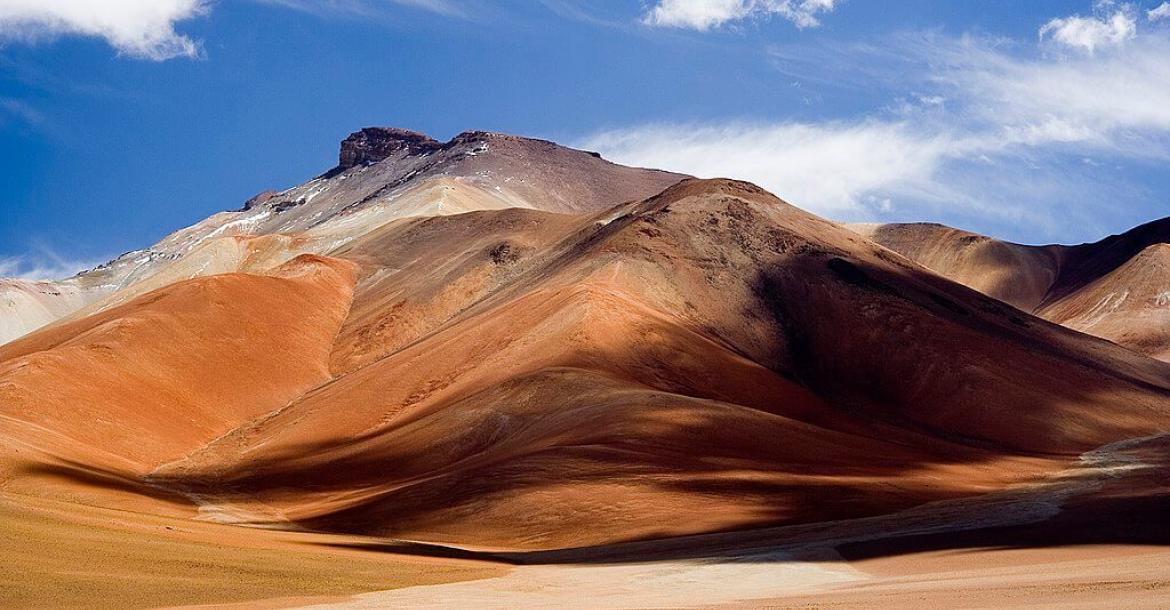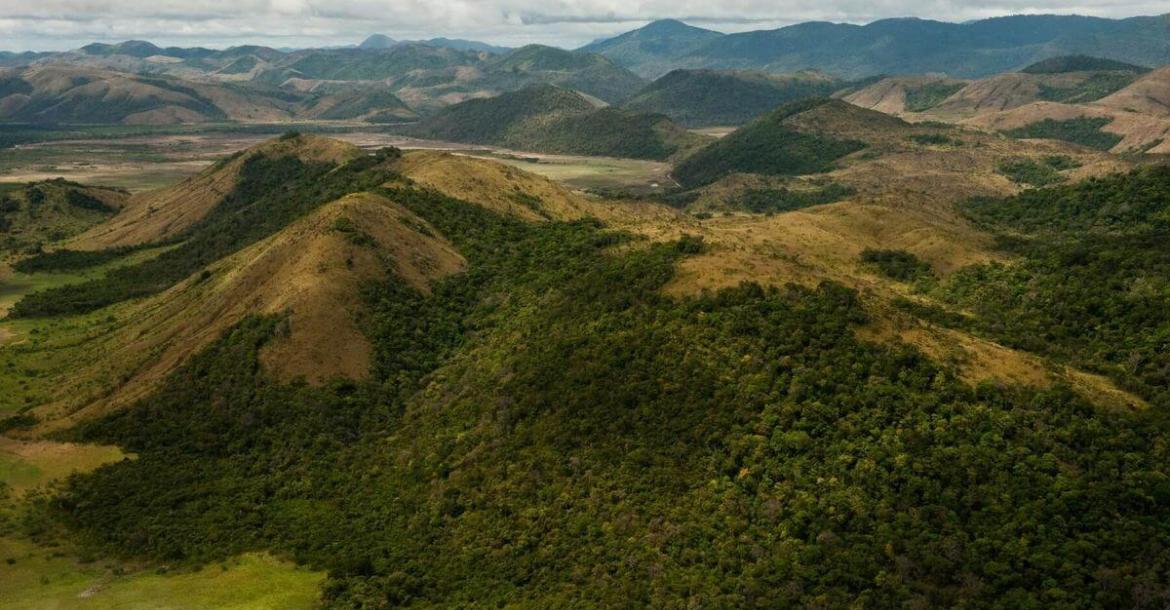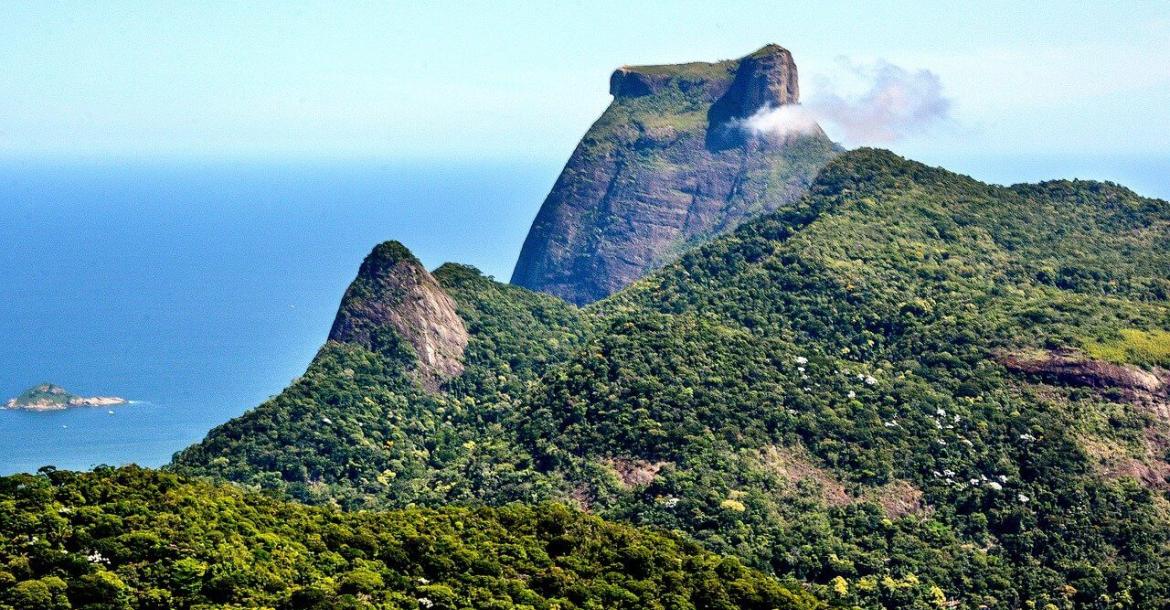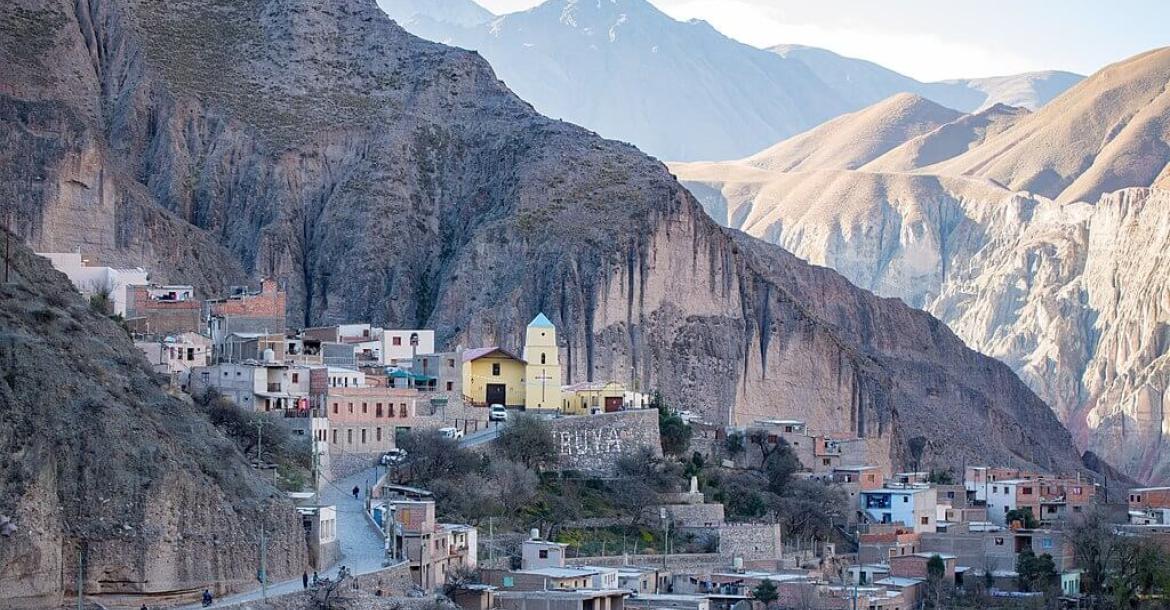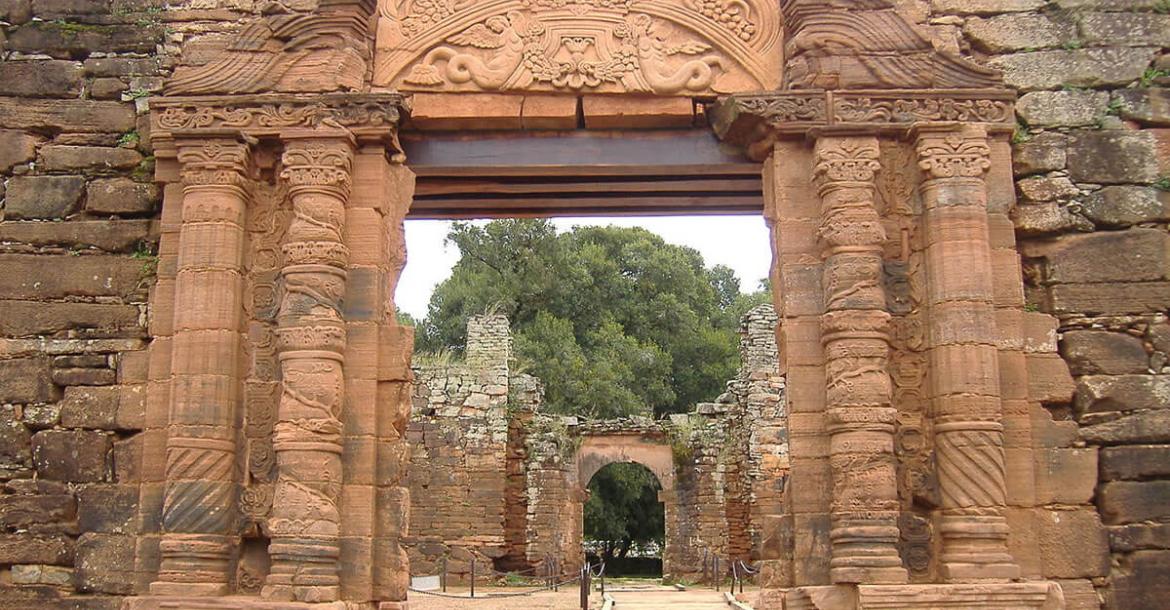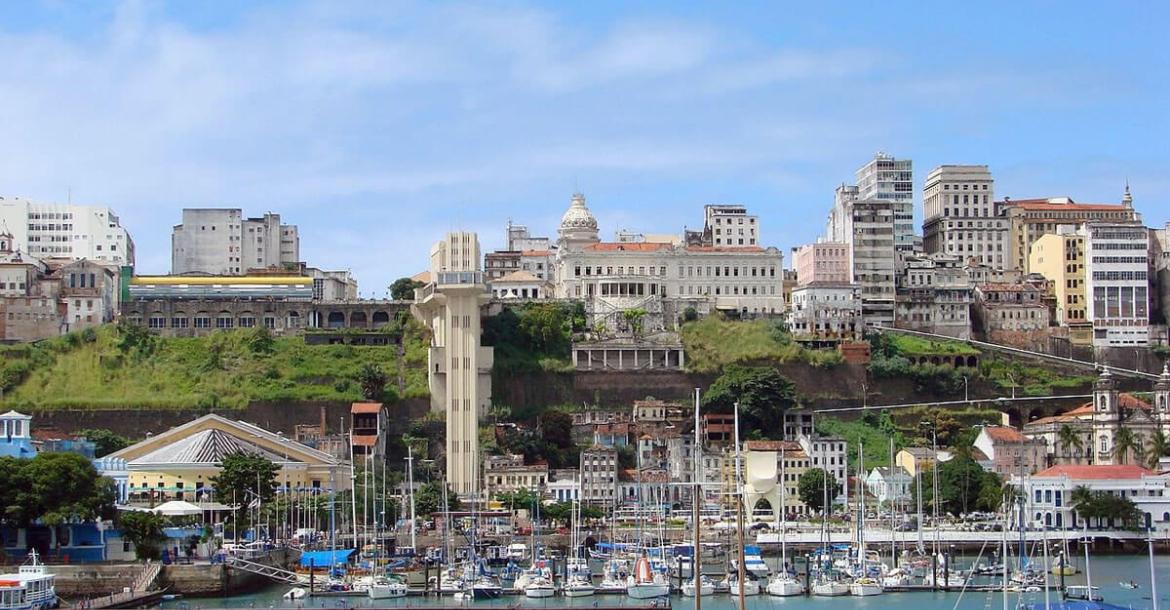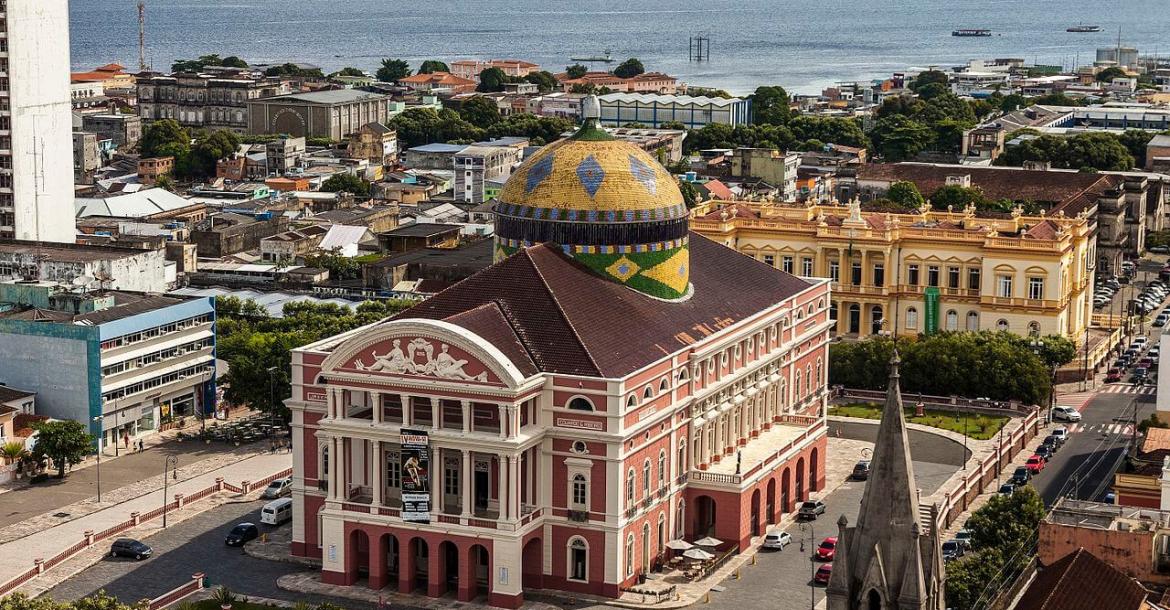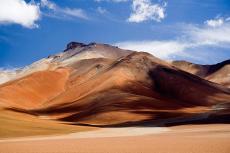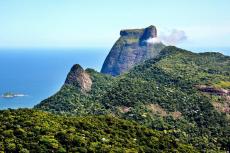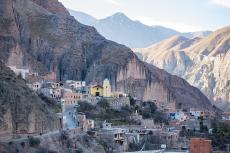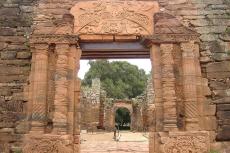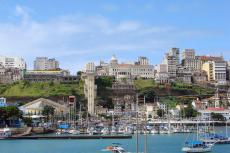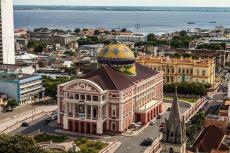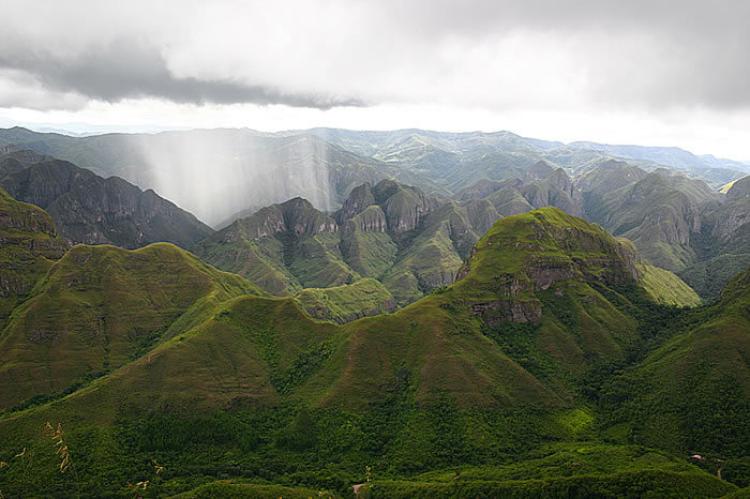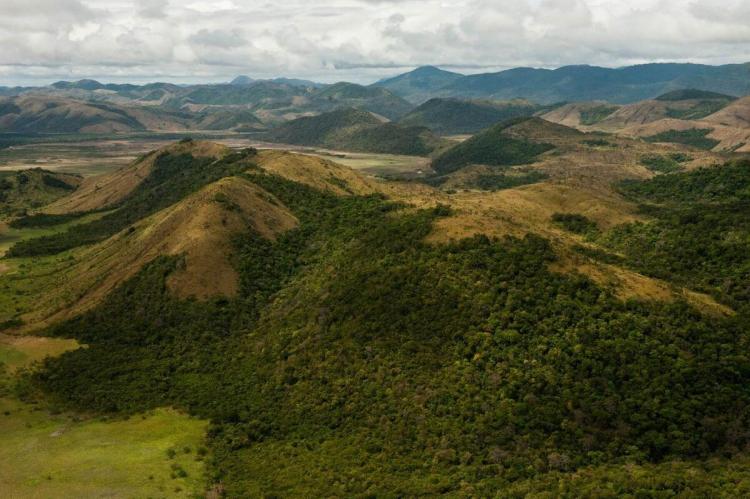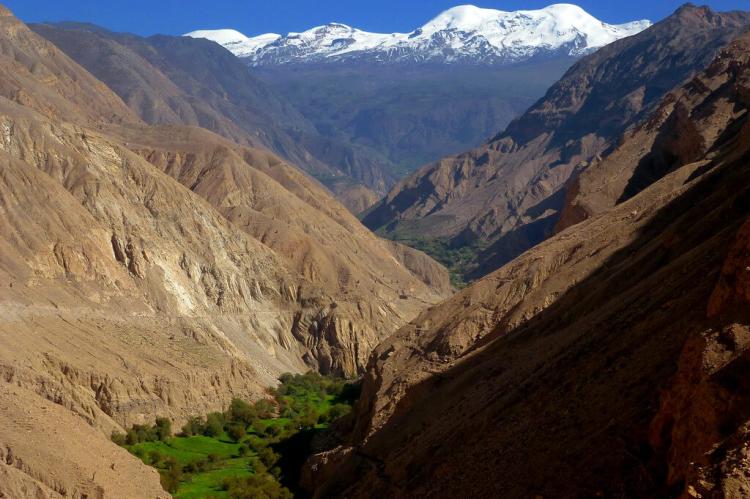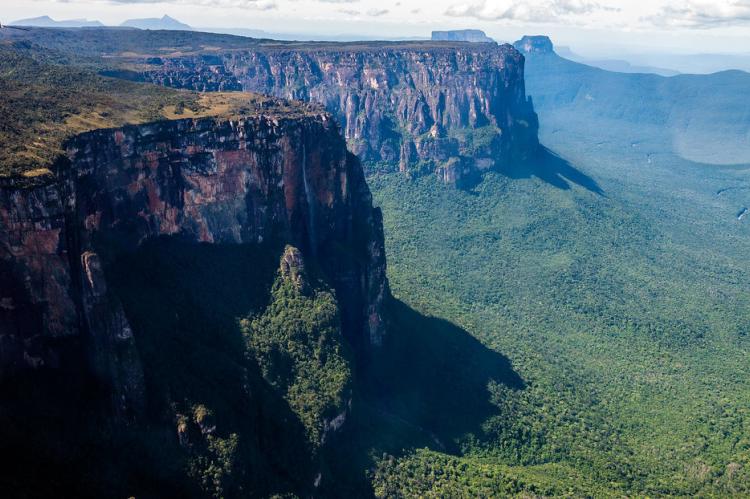The South American Continent: A Mosaic of Natural Splendor and Cultural Diversity
South America, situated between the Atlantic and Pacific Oceans, offers captivating beauty and cultural diversity, stretching from the Amazon jungles in the north to Patagonia in the south, creating a fantastic variety of landscapes that have mesmerized explorers and travelers for centuries.
The South American Continent
A Mosaic of Natural Splendor and Cultural Diversity
Nestled between the shimmering waters of the Atlantic Ocean to the east and the Pacific Ocean to the west, South America emerges as a continent of unparalleled beauty and cultural richness. It stretches from the steamy jungles of the Amazon Basin in the north to the icy reaches of Patagonia in the south, creating a rich diversity of natural and cultural landscapes that have captivated explorers, scientists, and travelers for centuries.
Encompassing twelve sovereign nations, including Brazil, Argentina, Peru, and many others, South America is defined by the grandeur of the Andes Mountains that traverse its western flank and the vastness of the Amazon Rainforest that blankets its eastern regions. This striking geography, formed over millions of years, has given rise to an astonishing array of ecosystems, from the high-altitude plateaus of the Altiplano to the fertile plains of the Pampas.
Spanning a staggering 17.84 million square kilometers (6.89 million square miles), South America's grandeur is not only in its size but also in the pivotal role it plays in shaping the world's environmental, cultural, and historical narratives. Its strategic location as the southernmost landmass of the Americas, combined with its remarkable geographical diversity, creates a kaleidoscope of climatic zones, biodiversity hotspots, and cultural influences that have shaped the continent's identity.
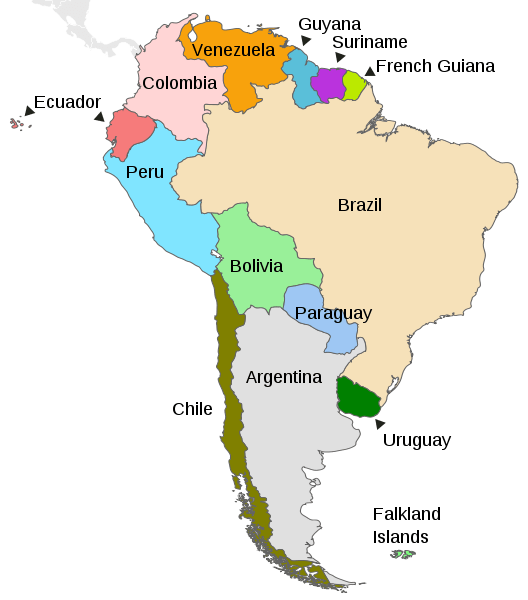
Map depicting the countries on the continent of South America
Natural and Geographical Landscape
South America's geographic diversity reflects the continent's natural beauty and cultural significance. As the world's fourth-largest continent, it encompasses many landscapes, each holding unique experiences and historical importance in the region's cultural heritage.
Natural Regions
South America's natural regions showcase diverse landscapes and ecosystems, from the majestic Andes Mountains to the lush Amazon Rainforest. The continent's geography encompasses tropical rainforests, arid deserts, high plateaus, and coastal areas, contributing to its distinctive identity and ecological significance.
Andes Mountains
The Andes Mountains, a colossal natural feature extending over 7,000 kilometers (4,300 miles), form Earth's most extended mountain range. This monumental geological formation has played a central role in shaping the identity of South America.
The Andes traverse multiple countries, including Colombia, Ecuador, Peru, Bolivia, Chile, and Argentina. These towering peaks, with their majestic snow-capped summits and awe-inspiring valleys, have long captivated the imagination of inhabitants and visitors alike.
Not only do the Andes offer breathtaking vistas and dramatic landscapes, but they also harbor a rich cultural legacy. Ancient civilizations like the Incas once thrived in these high altitudes, leaving behind a remarkable heritage of architecture, agriculture, and spirituality.
The terraced fields of Machu Picchu, perched on the Andean slopes, are a testament to the ingenuity and resourcefulness of these ancient peoples. The Andes continue to influence contemporary South American culture, with traditional practices, music, and art drawing inspiration from the region's rugged beauty.
Amazon Basin
On the opposite side of the continent lies the Amazon Basin, a colossal expanse of lush greenery and teeming biodiversity. The Amazon Rainforest, which blankets roughly 5.5 million square kilometers (2.1 million square miles), is the world's largest rainforest and a critical global ecosystem. Its dense canopy shelters an astonishing variety of plant and animal species, many of which are found nowhere else on Earth.
The Amazon River, the second-longest river globally, meanders through this verdant realm, infusing life into the region and fostering unique cultural traditions among its indigenous inhabitants.
The Amazon Basin is a biodiversity hotspot and a crucible of cultural diversity, where native peoples have cultivated their distinct languages, customs, and ways of life for generations. The rainforest's astounding richness and cultural significance make it a focal point of international conservation efforts and an enduring source of wonder.
Pampas and Patagonia
In the southern reaches of South America, two contrasting landscapes, the Pampas and Patagonia, offer a glimpse into the continent's geographical diversity. The Pampas, primarily spanning Argentina and Uruguay, are characterized by their vast, fertile plains.
These fertile lands have made the Pampas a hub for agriculture, particularly cattle ranching, which has been pivotal in shaping the region's economy and culture. Gauchos, the South American cowboys, have emerged as iconic figures, symbolizing the spirit of the Pampas and its distinctive way of life.
On the other hand, Patagonia is a land of stark beauty and untamed wilderness. This southernmost region of South America boasts rugged terrain, glaciers, fjords, and the legendary Tierra del Fuego.
Patagonia's unique landscapes have attracted adventurers, naturalists, and explorers for centuries, making it a captivating destination for those seeking the unspoiled beauty of the southern continent. Its remote and pristine environments have led to the establishment of numerous national parks and protected areas, preserving this enchanting wilderness for future generations.
Atacama Desert
To the north, the Atacama Desert, nestled in northern Chile, stands in stark contrast to the lushness of the Amazon. This arid desert is renowned as one of the driest places on Earth, characterized by its barren landscapes, surreal rock formations, and unique geological features.
The Atacama's ethereal beauty has drawn the attention of astronomers, who revel in its clear skies and minimal light pollution, making it an ideal location for stargazing and astronomical observations.
For adventurers, the Atacama offers a unique opportunity to explore one of the world's most extreme and awe-inspiring environments, with its salt flats, geysers, and otherworldly terrain.
Guiana Shield
The Guiana Shield is a geological formation covering parts of Venezuela, Guyana, Suriname, and French Guiana in the northern part of the continent. This ancient and stable landmass, characterized by its highlands and plateaus, is a cradle of biodiversity. It provides a habitat for unique species and has contributed to the cultural and ecological richness of the region.
Brazilian Highlands
The Brazilian Highlands, also known as the Brazilian Plateau, extend across much of Brazil and parts of neighboring countries. This vast elevated region encompasses diverse landscapes, from savannas and grasslands to dense forests. It significantly influences Brazil's climate, geography, and agriculture.
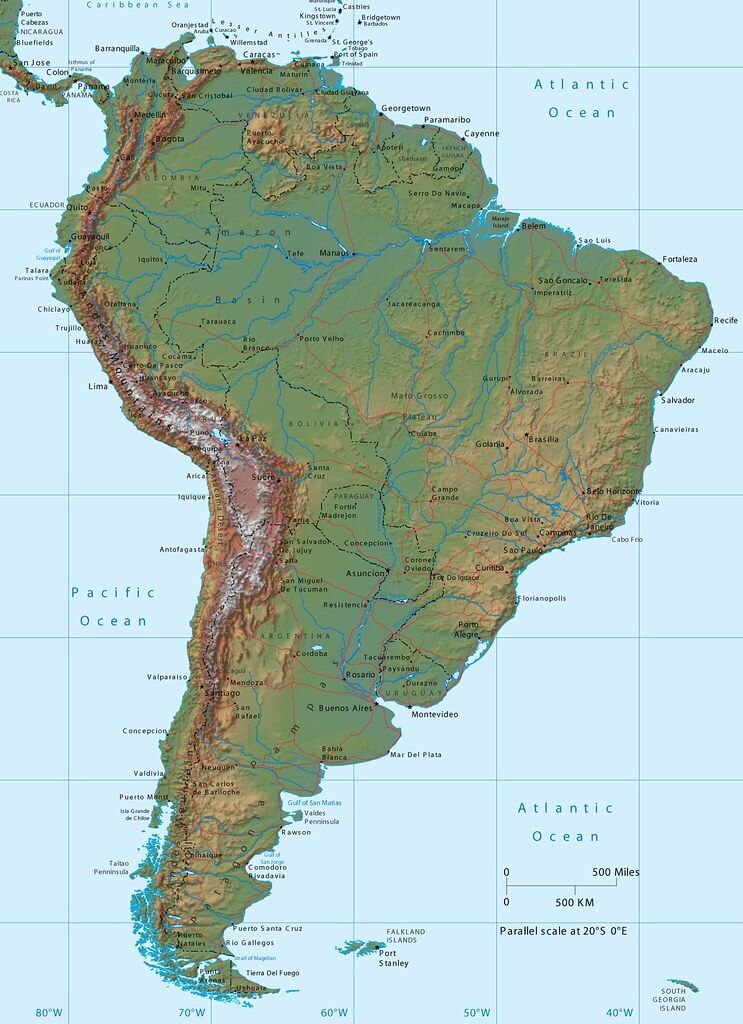
Physiographic map of South America
Rivers and Basins
South America has a network of rivers and basins that play a vital role in shaping the continent's geography, climate, and culture. Some of the world's most iconic rivers flow through this continent, contributing to its rich biodiversity and supporting the livelihoods of millions.
These rivers and basins not only sustain South America's ecological balance but also profoundly impact the continent's societies and economies. They provide water for agriculture, support diverse ecosystems, and offer transportation routes that link communities and foster economic development.
Additionally, South America's rivers are celebrated for their natural beauty and have inspired explorers, artists, and scientists throughout history.
Amazon River and Basin
The Amazon River is the lifeblood of South America, renowned as the world's second-longest river after the Nile. It traverses Brazil, Peru, Colombia, and several other countries, creating the Amazon Basin, the world's largest tropical rainforest. The basin covers an area of approximately 7 million square kilometers (2.7 million square miles), nurturing a staggering variety of flora and fauna.
The Amazon River and its tributaries are essential for transportation, provide freshwater resources, and profoundly impact the climate by absorbing and releasing vast amounts of water vapor, influencing the continent's weather patterns.
Orinoco River
Flowing through Venezuela and Colombia, the Orinoco River is another significant watercourse in South America. It drains into the Atlantic Ocean and is crucial for the communities living in the Orinoco Basin. The river's wetlands, such as the Llanos, provide vital grazing land for cattle and habitat for numerous species of birds and aquatic life.
Paraná and Paraguay Rivers
The Paraná River and Paraguay River are essential for trade and transportation in South America. Flowing through Brazil, Paraguay, and Argentina, the Paraná River is vital to the region's economy. It forms part of the La Plata Basin, which encompasses one of the world's largest wetland systems, the Paraná Delta.
This area is vital for biodiversity, serving as a habitat for numerous species, including the endangered La Plata River dolphin.
Madeira and Solimões Rivers
These two major tributaries of the Amazon River originate in the Andes of Peru and Bolivia. The Madeira and Solimões Rivers have created unique ecosystems within the Amazon Basin, hosting various aquatic species. The Madeira River is especially renowned for its impressive rapids and waterfalls.
Magdalena River
The Magdalena River flows through Colombia, traversing diverse landscapes from high mountains to lowlands. It plays a crucial role in transportation and irrigation and has historically been a significant trade route, connecting inland regions to the Caribbean coast.
Essequibo River
The Essequibo River, located in Guyana, is one of South America's major waterways, serving as an essential transportation route and source of freshwater. It flows through a variety of ecosystems, including lush rainforests and savannas.
Volcanology
South America is seismically active, with numerous volcanoes dotting its landscapes. The continent's volcanic regions are concentrated in the Andes, especially Chile and Ecuador. These volcanoes not only shape the physical geography but also have the potential to impact local communities and ecosystems. Volcanology plays a critical role in monitoring and understanding these geological phenomena, ensuring the safety and well-being of those nearby.
In summary, South America's geography is a collage of diverse landscapes, from towering mountains and vast rainforests to arid deserts and fertile plains. The continent's natural features, such as the Andes, the Amazon Basin, the Guiana Shield, the Brazilian Highlands, significant rivers, and volcanoes, contribute to its unique identity, ecological richness, and cultural diversity.
Climate
South America's climate is as diverse as its geography, with a wide range of climate zones influenced by the continent's extensive size, geographical features, and proximity to the equator. The continent experiences everything from tropical rainforests to arid deserts, from temperate regions to glacial landscapes.
Here is an overview of the major climate zones and their characteristics across South America:
Tropical Rainforest Climate
- Amazon Basin: The Amazon Basin, spanning Brazil, Peru, Colombia, and several other countries, is characterized by a hot and humid tropical rainforest climate. It experiences high temperatures year-round, with abundant rainfall and high humidity. The Amazon Rainforest, an iconic feature of this region, is perpetually green and teeming with life.
Tropical Savanna Climate
- Northern South America: Northern parts of South America, including parts of Colombia, Venezuela, and Guyana, have a tropical savanna climate. They experience distinct wet and dry seasons, with higher precipitation during the wet season and drier conditions during the dry season. This climate is typical of regions near the equator.
Arid and Semi-Arid Climates
-
Atacama Desert: The Atacama Desert, located in northern Chile, is one of the driest places on Earth. It features an arid climate with extremely low rainfall, and its landscapes are stark and barren.
-
Pampas: In Argentina, the Pampas region experiences a temperate climate with distinct seasons, but there are also areas with semi-arid climates, particularly in the western parts. These areas are characterized by lower rainfall and are often used for cattle ranching.
Temperate Climate
- Southern South America: Southern regions of South America, including parts of Chile and Argentina, have a temperate climate with four distinct seasons. Winters can be cold, and snowfall is not uncommon in the southernmost areas, while summers are milder. This climate is influenced by the proximity of these regions to the Southern Ocean.
Alpine and Glacial Climates
- Andes Mountains: As one of the highest mountain ranges in the world, the Andes exhibit a range of climates, including alpine and glacial climates. At higher altitudes, temperatures are much colder, and glaciers can be found, influencing local weather and ecosystems.
Climatic Zones in Central South America
- The Guiana Highlands and Brazilian Highlands: The Guiana Highlands and the Brazilian Highlands, which encompass parts of Venezuela, Guyana, Brazil, and surrounding areas, experience varied climates, with tropical rainforest climates in lower elevations and more temperate climates at higher altitudes. The highlands contribute to climatic diversity, impacting temperature and precipitation patterns.
Coastal Climates
-
Pacific Coast: The western coast of South America, along the Pacific Ocean, experiences a variety of coastal climates. In places like Lima, Peru, the climate is influenced by the cold Humboldt Current, resulting in cool and arid conditions. In contrast, regions like Valparaíso, Chile, have a Mediterranean climate with mild, wet winters and warm, dry summers.
-
Atlantic Coast: The eastern coast of South America, along the Atlantic Ocean, features a range of climates influenced by ocean currents. Coastal regions in Brazil experience a tropical climate, while southern areas, like Buenos Aires in Argentina, have a temperate climate with more pronounced seasons.
Volcanic Climates
- Volcanic Regions: Volcanic regions, primarily in countries like Chile and Ecuador, have their microclimates influenced by volcanic activity. Volcanic eruptions can lead to temporary changes in weather patterns, affecting local temperatures and air quality.
In summary, South America's climate diversity is a product of its vast geography, from the equatorial rainforests of the Amazon to the arid deserts of the Atacama and the temperate climates of the southern cone.
These varying climatic conditions play a crucial role in shaping the ecosystems, flora and fauna, and even the cultures and economies of the continent's nations. Understanding these climate patterns is essential for both environmental conservation efforts and the livelihoods of the people who call South America home.
Biodiversity
South America is celebrated as a biodiversity hotspot, offering an astonishing array of ecosystems, species, and habitats. The continent's diverse range of biomes and ecosystems, from lush rainforests to high-altitude plateaus, have made it a treasure trove for scientists and nature enthusiasts.
Here is an exploration of the critical biomes and ecosystems that define South America's remarkable biodiversity:
Amazon Rainforest
The Amazon Rainforest is one of the planet's most famous and biologically diverse ecosystems. It covers vast areas of Brazil, Peru, Colombia, and several other countries. This lush tropical rainforest is teeming with an incredible variety of plant and animal species, including jaguars, capybaras, sloths, toucans, and countless types of insects. The Amazon River and its tributaries wind through this region, sustaining a wealth of life and fostering unique adaptations.
Andean Paramo
In the Andes Mountains, the páramo is a unique ecosystem characterized by high-altitude grasslands, wetlands, and shrublands. It is found in countries such as Colombia, Ecuador, and Peru. The paramo supports a variety of specialized plant and animal species, including the endangered Andean condor and the spectacled bear. It also plays a crucial role in regulating water resources for downstream communities.
Chaparral and Mediterranean Forests
Parts of South America, particularly in Chile, feature Mediterranean-like ecosystems, including scrub and Mediterranean forests. Evergreen shrubs characterize these regions, providing habitat for the Chilean flamingo, South American gray fox, and many unique plant species. The flora and fauna of these ecosystems have evolved to cope with the Mediterranean climate's wet winters and dry summers.
Atlantic Forest
The Atlantic Forest, found along the eastern coast of Brazil, is a biologically rich and critically endangered ecosystem. It is home to diverse species, such as jaguars, golden lion tamarins, and the Brazilian tapir. Despite its high level of endemism and significance, this ecosystem has suffered extensive deforestation and habitat loss due to human activities.
Pantanal Wetlands
The Pantanal, located in Brazil and parts of Bolivia and Paraguay, is the world's largest tropical wetland area. It boasts a remarkable array of aquatic life, including caimans, capybaras, giant otters, and a profusion of bird species. The seasonal flooding of the Pantanal nurtures an ecosystem rich in biodiversity, and the Pantanal Conservation Area has been designated a UNESCO World Heritage Site.
Gran Chaco
The Gran Chaco is a vast semi-arid region stretching across portions of Argentina, Bolivia, and Paraguay. It is a mosaic of habitats, from thorn forests to savannas. The region supports unique species, such as the Chacoan peccary and the maned wolf, adapted to the arid conditions and seasonal flooding that characterize this ecosystem.
Highland Cloud Forests
In regions like the Yungas of Argentina and the cloud forests of Colombia and Ecuador, highland ecosystems are shrouded in mist and boast incredible plant and animal diversity. These forests are home to diverse species of orchids, hummingbirds, and mammals like the endangered Andean bear.
Gran Sabana
Venezuela's Gran Sabana is a surreal landscape of flat-topped mountains known as tepuis. These tabletop mountains are home to numerous unique plant and animal species. The area is famous for its stunning natural formations and inspiring Sir Arthur Conan Doyle's novel "The Lost World."
Galápagos Islands
The Galápagos Islands, situated off the coast of Ecuador, are renowned for their unique ecosystems and their role in Charles Darwin's theory of evolution. The islands are home to a wealth of distinctive wildlife, including giant tortoises, marine iguanas, blue-footed boobies, and frigatebirds.
Biodiversity Conservation
While South America's biodiversity is celebrated, it is also threatened by deforestation, habitat loss, and climate change. Numerous conservation efforts and national parks have been established to protect these unique ecosystems and their resident species.
Local communities, international organizations, and governments are working to preserve South America's remarkable biodiversity, recognizing the vital role these ecosystems play in maintaining the planet's ecological balance.
Culture
A Mosaic of Diversity
South America is a continent that weaves together a rich mosaic of cultures, traditions, and histories, reflecting the remarkable diversity of its people. The continent's cultural heritage is a vibrant blend of indigenous, European, African, and Asian influences, creating a unique and multifaceted identity celebrated throughout the region.
Indigenous Cultures
Indigenous peoples in South America have deep roots in diverse cultures, languages, and traditions. From the Quechua and Aymara in the Andes to the Guarani in the Gran Chaco, indigenous communities have preserved their heritage through art, music, and oral traditions.
Traditional clothing, such as colorful woven textiles, remains a significant cultural symbol in Peru and Bolivia. Andean music and dance, like the panpipes and huayno, are integral to their identities.
European Influence
Colonization by European powers, primarily Spain and Portugal, profoundly impacted South American culture. Spanish colonial architecture, art, and religion are evident throughout the continent. The fusion of indigenous and European influences gave rise to mestizo and criollo identities, creating a rich blend of traditions.
In countries like Argentina, tango music and dance, with its European and African roots, reflect the complex interplay of cultures.
African Heritage
The transatlantic slave trade brought a significant African influence to South America, particularly in countries like Brazil and Colombia. African rhythms and dance have enriched the continent's cultural landscape, giving rise to vibrant traditions like samba and cumbia. Afro-Brazilian religions, such as Candomblé and Umbanda, are also integral to the country's spiritual heritage.
Asian Communities
Countries like Peru and Brazil have substantial Asian immigrant communities, including Chinese and Japanese populations. Their influence is evident in South American cuisine, with dishes like Nikkei cuisine, which combines Japanese techniques with Peruvian ingredients. In Brazil, the Chinese influence on Brazilian food is evident in dishes like pastel and yakisoba.
Religion
Religion plays a significant role in South American culture. Roman Catholicism is the dominant religion, introduced by the Spanish and Portuguese during colonization. In many countries, Catholic traditions are interwoven with indigenous beliefs, giving rise to syncretic practices.
Festivals like Carnaval in Brazil and Inti Raymi in Peru blend Catholic and indigenous elements. Other religions, including Protestantism, Afro-Brazilian religions, and indigenous belief systems, also contribute to the continent's spiritual diversity.
Language:
Spanish and Portuguese are the primary languages spoken in South America, reflecting the colonial legacies of Spain and Portugal. However, many indigenous languages are still used, particularly in remote regions. In countries like Bolivia, multiple official languages, including Aymara and Quechua, reflect the nation's linguistic diversity.
Art and Literature:
South America has produced renowned artists, writers, and poets. Figures like Pablo Neruda, Gabriel García Márquez, and Jorge Luis Borges are celebrated worldwide for their contributions to literature.
The continent's art is diverse, with indigenous, colonial, and contemporary influences. Muralists like Diego Rivera and David Alfaro Siqueiros have significantly impacted the art world.
Cuisine:
South American cuisine is a reflection of its diverse culture and geography. Each country offers a unique culinary experience. Ceviche and quinoa are staples in Peru, while Argentina is famous for beef and asado barbecue. Brazilian cuisine is known for feijoada and acarajé, and the continent's use of ingredients like corn, potatoes, and cassava reflects its indigenous roots. The continent's wines and spirits, such as Chilean wine and Peruvian pisco, are also internationally acclaimed.
Music and Dance:
Music and dance are integral to South American culture. The continent has given the world diverse musical styles, from Argentina's tango to Brazil's samba. Instruments like the charango, panpipes, and marimba are used to create unique sounds, and festivals like the Rio Carnival and the Diablada in Bolivia showcase the vibrancy of South American dance.
Festivals and Traditions:
South America boasts a wide array of festivals and traditions. The Day of the Dead in Mexico, Carnival in Brazil, and the Inti Raymi festival in Peru are just a few examples. These celebrations often blend indigenous and European traditions, creating colorful and lively events that draw visitors worldwide.
Summary
In summary, the culture of South America is a captivating blend of indigenous, colonial, African, and global influences. It is a testament to the continent's enduring cultural diversity and resilience, where tradition and innovation coexist, shaping the identity of South American societies and contributing to the world's cultural heritage.
